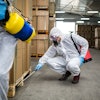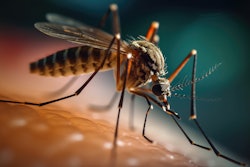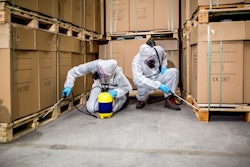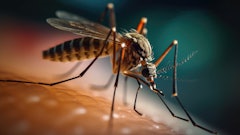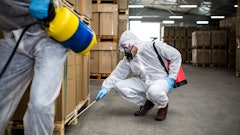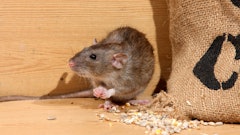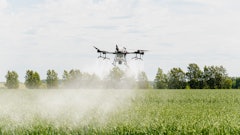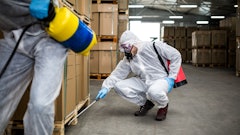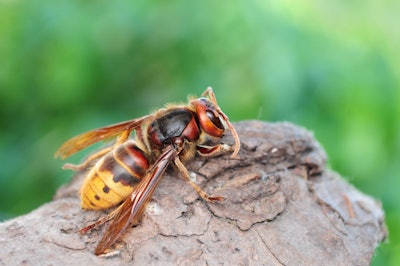
This past August, the yellow-legged hornet, another invasive hornet from Asia, was discovered for the first time in the U.S. southeast Georgia near Savannah. A predatory species, the presence of the yellow-legged hornet poses a threat to honeybees and other pollinators in North America. As of September, there have been two nests found and destroyed by the United States Department of Agriculture (USDA) agency Animal & Planet Health Inspection Service (APHIS), Georgia Department of Agriculture (GDA), and researchers at the University of Georgia and the University of Florida. While the nest has hopefully not been established, it’s good to be aware of this pest and the impacts it can have on the agriculture industry, a main economic driver in the southeast United States, especially.
About the yellow-legged hornet
The yellow-legged hornet (Vespa velutina) is native to tropical and subtropical areas of Southeast Asia. This hornet is a social wasp species, constructing egg-shaped nests, often located in trees that can average 6,000 workers. They are slightly smaller than another established invasive hornet, the European hornet (Vespa crabo), and slightly larger than bald-faced hornet (Dolichovespula maculate), a native species which is a type of yellowjacket. The legs of the yellow-legged hornet are primarily yellow toward their feet, giving it its common name.
Yellow-legged hornet and agriculture
As a non-native species, the yellow-legged hornet is a voracious predator that can feed on local insects, many of which are pollinators. They can be particularly troublesome for honeybee keepers where the yellow-legged hornet can cause significant damage to hive worker populations and hive failure. In Georgia where they were first found, the main threat is to agriculture, which relies on pollinators — both native and managed — for efficient crop pollination. If the yellow-legged hornet were to become established like it has in other countries (China, Japan, Korea, France, Spain and other European countries), it could directly impact crop yields and farming.
The yellow-legged hornet is also a social insect protective of its nest, so as with other hornets it is best to leave them alone and avoid nests. Yellow-legged hornets typically nest in trees but can sting multiple times and will aggressively defend their nest if they feel threatened, which can pose a serious health risk to individuals with allergic reactions to the stings.
Stinging pests and integrated pest management
Protect your facility — and employees — against stinging pests such as hornets by implementing an integrated pest management (IPM) program.
IPM programs focus on preventive techniques like exclusion, sanitation and ongoing monitoring and maintenance to keep pests where they belong — outside the facility. Most food processing facilities have customized IPM programs in place, especially if they undergo regular third-party food safety audits. These programs are implemented by qualified pest control technicians in collaboration with a facility’s food safety and quality assurance team to help deter pest activity and prevent infestations.
When it comes to stinging pests, there are a variety of techniques that can help keep these pests at bay:
· Maintain property grounds. Elaborate landscaping makes your property more attractive to employees, potential clients and flying, stinging pests alike. Trimming overgrown branches, keeping plants from touching the exterior of your building and surveying and maintaining mulching can help deter and detect stinging insect nests early in the season when they are easiest to address.
· Secure the exterior. Perhaps the most important preventive measure you can take when it comes to helping eliminate pests inside your facility is implementing exclusion tactics. Exclusion refers to techniques that include the repairing, sealing off and shutting down of any common entry points for pests around the facility. Some species of yellowjackets and European hornets can make nests in wall voids. Make sure to inspect your exterior with your pest control provider to determine where you can continue to secure your facility’s exterior.
· Keep it clean. Maintaining a clean facility is essential for helping keep any pests at bay. Make sure you clean your facilities daily, wiping down surfaces, removing clutter and regularly emptying trash cans. Exposed trash and food debris can inadvertently attract stinging pests to your facility.
· Train staff. Investing in a staff training plan that can teach employees how to spot signs of stinging pests is also an effective way to help prevent an infestation. Your employees see and hear more than you might know, which makes them invaluable in helping identify pest issues. Once staff knows the types of stinging pests that frequent the facility, persistent hot spots, and the process for reporting pest activity, they’ll be able to help address pest issues quickly and effectively. And most pest control providers offer complimentary staff training, making this tactic cost-effective for your operations.
Ongoing monitoring for stinging pests around the facility
In case of a stinging pest nesting at the facility, it is important to quickly notify a pest control provider. Keeping detailed records of where they were seen and high activity times of day can assist in quickly diagnosing the issue and removing the threat. And review your IPM plan with a pest control provider. If you don’t have an IPM program in place or a reliable pest control provider, now’s the time to implement one before it becomes a costly pest issue — or worse, brings harm to your employees and customers.
Staying on top of stinging pests can help keep employees safe and business running smoothly. While the yellow-legged hornet is not a current emergency threat to food processors, it is a threat to pollinators and warrants the government eradication program and citizen support. If you think you have spotted a yellow-legged hornet in or near your facility, contact your local Department of Agriculture immediately for assistance.


